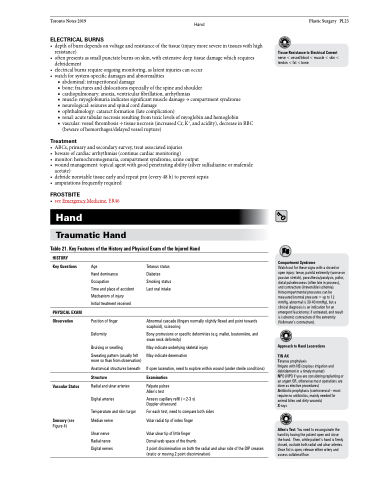Page 1145 - TNFlipTest
P. 1145
Toronto Notes 2019 Hand
ELECTRICAL BURNS
• depthofburndependsonvoltageandresistanceofthetissue(injurymoresevereintissueswithhigh resistance)
• often presents as small punctate burns on skin, with extensive deep tissue damage which requires debridement
• electricalburnsrequireongoingmonitoring,aslatentinjuriescanoccur
• watchforsystem-specificdamagesandabnormalities
■ abdominal: intraperitoneal damage
■ bone: fractures and dislocations especially of the spine and shoulder
■ cardiopulmonary: anoxia, ventricular fibrillation, arrhythmias
■ muscle: myoglobinuria indicates significant muscle damage → compartment syndrome
■ neurological: seizures and spinal cord damage
■ ophthalmology: cataract formation (late complication)
■ renal: acute tubular necrosis resulting from toxic levels of myoglobin and hemoglobin
■ vascular: vessel thrombosis → tissue necrosis (increased Cr, K+, and acidity), decrease in RBC
(beware of hemorrhages/delayed vessel rupture)
Treatment
• ABCs,primaryandsecondarysurvey,treatassociatedinjuries
• bewareofcardiacarrhythmias(continuecardiacmonitoring)
• monitor:hemochromogenuria,compartmentsyndrome,urineoutput
• woundmanagement:topicalagentwithgoodpenetratingability(silversulfadiazineormafenide
acetate)
• debridenonviabletissueearlyandrepeatprn(every48h)topreventsepsis • amputationsfrequentlyrequired
FROSTBITE
• seeEmergencyMedicine,ER46 Hand
Traumatic Hand
Table 21. Key Features of the History and Physical Exam of the Injured Hand
Plastic Surgery PL23
Tissue Resistance to Electrical Current
nerve < vessel/blood < muscle < skin < tendon < fat < bone
HISTORY
Key Questions
PHYSICAL EXAM
Observation
Vascular Status
Sensory (see Figure 4)
Age
Hand dominance Occupation
Time and place of accident Mechanism of injury
Initial treatment received
Position of finger Deformity
Bruising or swelling
Sweating pattern (usually felt more so than from observation)
Anatomical structures beneath
Structure
Radial and ulnar arteries Digital arteries
Temperature and skin turgor Median nerve
Ulnar nerve Radial nerve Digital nerves
Tetanus status Diabetes Smoking status Last oral intake
Abnormal cascade (fingers normally slightly flexed and point towards scaphoid), scissoring
Bony protrusions or specific deformities (e.g. mallet, boutonnière, and swan neck deformity)
May indicate underlying skeletal injury May indicate denervation
If open laceration, need to explore within wound (under sterile conditions)
Examination
Palpate pulses Allen’s test
Assess capillary refill (<2-3 s) Doppler ultrasound
For each test, need to compare both sides Volar radial tip of index finger
Volar ulnar tip of little finger Dorsal web space of the thumb
2 point discrimination on both the radial and ulnar side of the DIP creases (static or moving 2 point discrimination)
Compartment Syndrome
Watch out for these signs with a closed or open injury: tense, painful extremity (worse on passive stretch), parasthesia/paralysis, pallor, distal pulselessness (often late in process), and contracture (irreversible ischemia). Intracompartmental pressures can be measured (normal pressure = up to 12 mmHg, abnormal is 30-40 mmHg), but a clinical diagnosis is an indication for an emergent fasciotomy; if untreated, end result is ischemic contracture of the extremity (Volkmann’s contracture).
Approach to Hand Lacerations
TIN AX
Tetanus prophylaxis
Irrigate with NS (copious irrigation and debridement in a timely manner)
NPO (NPO if you are considering replanting or an urgent OR, otherwise most operations are done as elective procedures)
Antibiotic prophylaxis (controversial – most require no antibiotics, mainly needed for animal bites and dirty wounds)
X-rays
Allen’s Test: You need to exsanguinate the hand by having the patient open and close thehand. Then,whilepatient’shandisfirmly closed, occlude both radial and ulnar arteries. Once fist is open, release either artery and assess collateral flow


